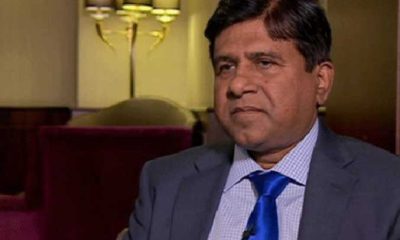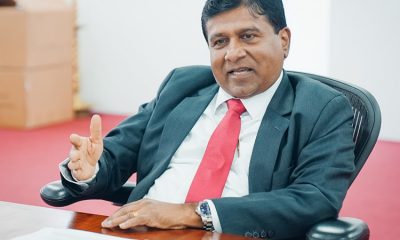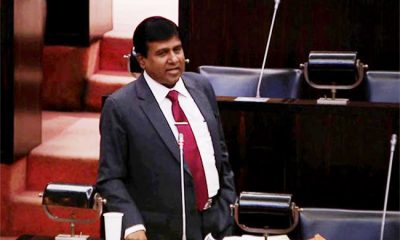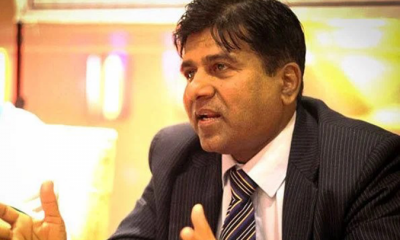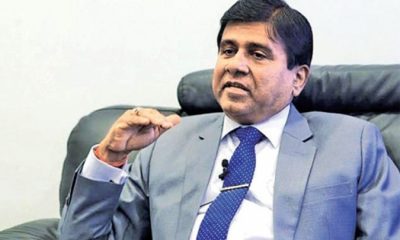Opinion
Navigating course of education reforms in SL: Past challenges and future directions

by Prof. M.W. Amarasiri de Silva
The government has proposed abolishing the University Grants Commission (UGC) set up under the Universities Act No. 16 of 1978 and replacing it with an independent body called the “National Higher Education Commission.” This change is set to be enacted through new legislation. As the Chairman of the Select Committee, Minister Wijeyadasa Rajapakshe has recommended the National Higher Education Commission will consist of 11 members appointed by the President, subject to prior approval from the Constitutional Council. These members are expected to be eminent individuals in their respective fields, including academia, profession, and management. Accordingly, the proposed Commission will be organized into four sub-committees: the State University Committee, the Non-State University Committee, the Vocational Education Institutions Committee, and a sub-committee dedicated to quality assurance. Each sub-committee will focus on specific aspects of higher education in the country. Wijeyadasa Rajapakshe, PC, emphasized that opportunities for higher education should be expanded to match the labour market.
In implementing the proposed reforms, it is crucial to take into consideration the existence of various government-formed institutions that have been dealing with different aspects of education over the years. The new proposal, as published in the newspapers, lacks specific information on how these institutions will be addressed and what changes they might undergo. One important institution to consider is the National Institute of Education (NIE), which was established in 1985 through an Act of Parliament. The NIE was entrusted with the vital tasks of curriculum development and awarding degrees in education to support the professional development of teachers, principals, and educational administrators. However, the proposal does not clarify how the new curriculum development committee will impact the role and functions of the NIE.
Similarly, the formulation of the national education policy relies on the recommendations provided by the National Education Commission (NEC), which was established in 1991 through an Act of Parliament. The NEC holds a pivotal role in shaping the nation’s education policy. Yet, it remains uncertain how the proposed reforms will affect the NEC’s position and functions.
Another significant institution is the Curriculum Development Centre (CDC), established in the 1960s. Initially focused on developing curricula for science and mathematics, the CDC has evolved over time to encompass curricula development across all subjects and has contributed to teacher development efforts. It is essential to address the potential impact of the new proposals on the CDC and its continuing role in education reform.
To ensure the success of the proposed reforms, it is imperative that the fate and functions of these existing institutions are explicitly addressed and aligned with the broader vision of the educational changes being proposed. Clarity on their roles and potential restructuring will help in achieving a more cohesive and effective education system in the country.
Why can these changes not be implemented within the structure of the University Grant Commission and the institutions setup to deal with various aspects of education in the country? This article reviewing the history of education reforms in Sri Lanka tries to answer these questions.
Sri Lanka’s history of education reforms has been marked by the establishment of various committees and programs proposed by successive governments over the years. In 1975-76, the government made a significant effort to further strengthen its control over the universities through amendments to the University of Ceylon Act No. 1 of 1972. These proposed amendments aimed to increase the government’s authority over the universities, much like the recently proposed reforms by the Minister of Higher Education.
However, the introduction of these amendments faced opposition from the universities and students, who were concerned about the concentration of powers in the hands of the government. The proposed amendments had to be withdrawn in response to widespread trade union actions and dissent.
The political landscape shifted in 1997, with the opposition party winning the election. They made a crucial pledge to grant autonomy to individual universities, and this promise was championed by Ronnie de Mel and the United National Party (UNP).
These historical episodes illustrate the ongoing struggle to balance government influence and university autonomy in Sri Lanka’s higher education system. The currently proposed reforms should consider these past experiences to ensure a harmonious and practical approach to shaping the future of education in the country. Acknowledging the crucial role of education in the country’s development, the ministers of higher education have consistently sought to reshape the higher education landscape, even though the universities were considered autonomous institutions according to the Universities Act, No. 16 of 1978. This emphasis on education reform arises from the belief that a robust and dynamic education system, encompassing both school and university education, is indispensable for propelling the nation’s progress and prosperity. As such, it becomes the government’s prerogative to introduce changes to achieve this goal.
The most pivotal and ground-breaking reform that laid the foundation for Sri Lanka’s free education system was the comprehensive overhaul of the educational framework in 1945. This transformative reform was built upon the principles outlined in the Education Ordinance No. 31 of 1939, making it the foremost and all-encompassing reform ever undertaken in the country’s educational history. During this period, C.W.W. Kannangara, who held the education portfolio in the State Council from 1931 to 1947, played a crucial role with A. Ratnayake in revolutionizing the education system.
The education reforms of 1945 brought about significant changes—the reforms aimed to provide free education from kindergarten up to university level. Swabhasha (Sinhala and Tamil) was established as the primary medium of instruction in schools, while English continued to have its place as a language taught from Standard III onwards. This emphasis on both languages sought to strike a balance between preserving the country’s cultural identity and enabling students to engage with a globalised world.
Most significantly, these reforms opened opportunities for children from rural areas and less privileged backgrounds to access education. Central Colleges, established by the government, played a crucial role in this process by providing accessible education to village children, enabling them to climb the social ladder through learning and knowledge.
In contemporary times, the history of university education in Sri Lanka spans just over a few decades. From 1921 to 1959, the country had only one educational institution offering university-level education, University College (1921–1942), affiliated with the University of London. In 1942, following 21 years of agitation, the University of Ceylon was finally established at Peradeniya. Subsequently, in 1959, the education landscape underwent a significant transformation with the establishment of two additional universities – Vidyalankara and Vidyodaya- the two main centres of Buddhist learning in Ceylon were swiftly converted into universities. This expansion led to recognising the necessity for a coordinating body to oversee higher education activities. In 1966, the National Council of Higher Education (NCHE) was established as a part of a policy to increase government influence over universities.
In 1979, the University Grants Commission (UGC) was established, equipped with powers akin to the National Council of Higher Education (NCHE). However, the UGC’s authority extended even further, surpassing the scope enjoyed by the British UGC. Notably, Professor S. Kalpage, a highly experienced university teacher with a diverse academic background, was appointed as the inaugural chairman of the UGC. Interestingly, he also held the position of Secretary of the Ministry of Higher Education.
The appointment of Professor S. Kalpage as the first chairman of the UGC was a strategic decision by the government, aimed at avoiding potential conflicts between the Ministry of Higher Education and the newly formed UGC during its initial developmental years. This move demonstrated the government’s proactive approach to ensure a harmonious working relationship between these entities and facilitate a smooth and effective implementation of the UGC’s role in shaping higher education in the country.
In 2016, G.B. Gunawardene, the National Education Commission (NEC) chairman, pointed out that the 1939 Rathnayaka-Kannangara Education Ordinance (No. 31 of 1939) remains the foundational law of education in Sri Lanka. Despite several subsequent acts introduced for different aspects of education, there have been no meaningful amendments or changes to the core education law. Dr. Gunawardene emphasized the need for an education policy framework rather than new acts to address the challenges and requirements of the modern education system.
Regarding the possibility of a new act, it’s essential to clarify that introducing a new law does not necessarily mean the 1939 act would be annulled. The new act could be complementary, addressing specific areas or aspects of education that may require updated regulations. However, the 1939 act would remain the foundation and overarching framework for education in the country unless it is explicitly repealed or replaced.
The national university of Ceylon was started in 1942, and no particular administrative unit was within that ministry to deal with the university. The only formal link was provided by one of the officials of the ministry, the director of education, who was the principal administrative officer in control of primary and secondary education in the country’s state education sector, and an ex officio member of the council, the university’s governing body.
The significant shift and political interventions in university education occurred following the formation of the 1956 government and its political interventions. This period witnessed notable changes, including an increase in student enrolment, particularly in the arts and social sciences fields. Moreover, there was a shift in the medium of instruction from English to Sinhalese and Tamil, a move perceived as an apolitical endeavour for social justice.
However, this new approach diverged from the vision of the Kannangara-Ratnayake reforms, which aimed to strike a balance by using English as the language of instruction from the 3rd standard while promoting the use of swabhasha (Sinhala and Tamil) as the medium of instruction. The introduction of the new system marked a departure from the previous reform’s principles.
The historical context of education reforms in Sri Lanka dates to the era of IMRA Iriyagolla, during which the higher education system experienced significant upheaval. Although the specific details of the havoc caused during that time are not mentioned, it serves as a reminder that changes in the education sector have not always been smooth and have sometimes encountered challenges and controversies.
Subsequently, in response to the need for comprehensive administration and oversight of the country’s universities, the idea of establishing the University Grants Commission (UGC) emerged. The idea was mooted when Premadasa Udagama, Secretary of Education and the Director General of the Ministry of Education from 1970 to 1977. The UGC aimed to unify all universities under one administrative umbrella, streamlining processes and enhancing coordination among the higher education institutions. Establishing the UGC marked a significant step forward in Sri Lanka’s efforts to reform and improve the higher education system. This centralised approach sought to address various administrative and operational inefficiencies that might have hindered the optimal growth and development of universities. Through the UGC, the government aimed to ensure that universities received adequate funding, maintained high academic standards, and aligned their programmes with national development priorities. (To be continued)
Opinion
Remembering Dr. Samuel Mathew: A Heart that Healed Countless Lives

It is with a deeply heavy heart that I express my sincere condolences on the passing of Dr. Samuel Mathew Kalarickal on the 20th of April 2024. Born in 1948, Dr. Samuel was not only a pioneer of interventional cardiology in India but a giant in South Asian healthcare whose influence extended far beyond national borders.
A Beacon of Excellence and Compassion
Known as the “Father of Angioplasty” in India, Dr. Samuel introduced life-saving coronary interventions when they were still rare. His leadership at Apollo Hospitals and Kokilaben Dhirubhai Ambani Hospital brought cardiac care to global standards. But beyond the accolades, it was his humility, compassion, and unwavering dedication to patients that truly set him apart.
A Lasting Impact on Sri Lanka
Dr. Samuel played a pivotal role in shaping modern cardiac care in Sri Lanka. In the 1990s and early 2000s, many Sri Lankan patients sought his expertise in India, trusting him with their lives. He treated them with care and dignity, leaving lasting impressions on families across the island.
He also trained and mentored numerous Sri Lankan cardiologists, generously sharing knowledge of advanced procedures and technologies. His efforts helped uplift cardiac care back home and empowered many of us to bring those skills to our own communities.
A Mentor Who Lit the Path
To me, Dr. Samuel was more than a mentor—he was a fatherly figure. I fondly recall our time at the 2011 Coimbatore meeting, where he urged me to form the Sri Lanka STEMI Forum. His guidance helped us create national strategies and treatment models for heart attack care—an initiative that continues to save lives today.
A Legacy That Lives On
Dr. Samuel leaves behind more than medical breakthroughs. He leaves behind a legacy of service, inspiration, and heart. His memory will live on in every life he touched, every doctor he guided, and every patient he healed.
You will be remembered always, Sir—not just for what you did, but for who you were.
May your soul find eternal peace.
– Dr Gotabhaya Ranasinghe
Opinion
Trump tariffs and their effect on world trade and economy with particular reference to Sri Lanka – Part V

(Continued from yesterday)
Domestic Market Development
While Sri Lanka’s relatively small domestic market (22 million people) limits the potential for inward-focused development, there may be opportunities to reduce import dependence in certain sectors and develop stronger linkages between export industries and domestic suppliers. This could create more balanced growth and reduce vulnerability to external shocks.
Policies to support domestic market development might include,
-
Import Substitution in Strategic Sectors: Targeted support for domestic production of essential goods and inputs to export industries, reducing dependency on imports.
-
Strengthening Domestic Supply Chains: Developing stronger linkages between export-oriented firms and local suppliers to increase domestic value addition.
-
Addressing Income Inequality: Policies that increase purchasing power among lower and middle-income Sri Lankans could expand the domestic market for locally produced goods and services.
Such approaches would need to avoid the pitfalls of earlier import substitution models that created inefficient, protected industries. The focus should be on developing competitive domestic capabilities rather than simply erecting barriers to imports.
Policy Recommendations
Based on the analysis of both short-term and longer-term strategies, several specific policy recommendations emerge for Sri Lanka,
Industrial Policy Reforms
Sri Lanka should develop a comprehensive industrial policy that goes beyond the current focus on export promotion to address structural vulnerabilities revealed by the tariff shock. This policy should,
-
Identify priority sectors for diversification based on a realistic assessment of Sri Lanka’s competitive advantages and global market opportunities.
-
Provide targeted support for research and development, skills training, and quality infrastructure in these priority sectors.
-
Reform regulatory frameworks to reduce barriers to business formation, innovation, and growth.
-
Develop specific strategies for upgrading within existing export sectors like textiles, helping firms move into higher-value activities.
Investment in Innovation and Skills
Human capital development represents a critical foundation for economic resilience and diversification. Sri Lanka should,
-
Align education and training systems more closely with emerging economic opportunities, emphasizing technical skills, digital literacy, and innovation capabilities.
-
Support university-industry collaboration to develop applied research relevant to Sri Lanka’s economic challenges.
-
Facilitate knowledge transfer through diaspora engagement, international partnerships, and strategic foreign direct investment.
-
Develop innovation hubs and incubators focused on priority sectors for diversification.
Sustainable Debt Management
The tariff shock highlights the importance of building greater resilience into Sri Lanka’s approach to external debt. Recommendations include,
-
Advocating for reforms to international debt restructuring frameworks that would explicitly link repayment obligations to export performance, similar to the London Debt Agreement model.
-
Developing contingency clauses in future debt agreements that would automatically adjust payment terms in response to external shocks beyond the country’s control.
-
Prioritizing concessional financing over commercial borrowing where possible to reduce vulnerability to market sentiment.
-
Building stronger foreign exchange reserves during periods of stability to provide buffers against future shocks.
Social Protection for Affected Workers
Finally, Sri Lanka must develop more robust systems to protect vulnerable workers during economic transitions. Recommendations include,
-
Establishing a dedicated adjustment assistance program for workers displaced by trade shocks, providing income support, retraining, and job placement services.
-
Developing community-based support initiatives in regions highly dependent on export industries.
-
Engaging international partners to support these efforts through technical and financial assistance.
-
Ensuring that economic diversification strategies explicitly address employment creation for workers with different skill profiles.
Implementing these recommendations would require significant political will, institutional capacity, and international support. However, the current crisis created by President Trump’s tariffs also presents an opportunity to address long-standing structural vulnerabilities and build a more resilient economic model for Sri Lanka’s future development, just like what Sri Lanka did post economic crisis, such as tax reforms, SOE reforms and cost reflective pricing.
CONCLUSION
The imposition of sweeping tariffs by the Trump administration represents a profound disruption to the global trading system with far-reaching consequences for economies around the world. As we have seen throughout this analysis, these tariffs are not merely technical adjustments to trade policy but potentially transformative shifts that challenge fundamental assumptions about economic development, international cooperation, and the distribution of benefits and costs in our interconnected global economy.
For Sri Lanka, the 44% tariff rate imposed on its exports to the United States threatens to undermine a fragile economic recovery and reverse hard-won progress following the devastating crisis of 2022. With the United States accounting for 23% of Sri Lanka’s exports and the textile industry, which employs 350,000 workers, particularly vulnerable to this trade shock, the human consequences could be severe. Projected losses of $300 million in annual export earnings not only threaten jobs and livelihoods but also raise serious concerns about Sri Lanka’s ability to service its external debt obligations, despite recent restructuring efforts.
Sri Lanka’s experience illuminates broader structural vulnerabilities in the global economic system. The export-led development model promoted by international financial institutions for decades has created deep dependencies on continued access to wealthy consumer markets, particularly the United States. When this access is suddenly restricted through unilateral policy decisions, developing countries bear disproportionate adjustment costs with limited capacity to cushion the impact. The international trade and financial architecture offer inadequate mechanisms to address such shocks, with debt sustainability frameworks failing to properly account for trade performance and multilateral institutions lacking effective tools to prevent or mitigate the damage.
This situation calls for both immediate crisis response and longer-term structural reforms. In the short term, Sri Lanka must pursue diplomatic engagement with the United States, provide targeted support to affected industries within its fiscal constraints, and implement emergency measures to protect vulnerable workers. Over the longer term, strategies for market and product diversification, value chain upgrading, regional integration, and domestic market development offer pathways to greater resilience, though none provides a quick or easy solution to the current challenge.
Beyond Sri Lanka’s specific circumstances, President Trump’s tariffs may accelerate broader shifts in global trade patterns. We may see increased regionalization of trade, a greater role for China as both market and investor for developing economies, production relocation to avoid tariffs, and renewed interest in South-South cooperation and domestic market development. These shifts could fundamentally reshape the global economic landscape in ways that create both risks and opportunities for developing countries.
The tariff shock also highlights the need for more fundamental reforms to the international economic system. A more equitable approach to trade and development would recognize the structural challenges facing developing economies and provide meaningful policy space for them to pursue diversification and resilience-building strategies. Debt sustainability frameworks should explicitly link repayment obligations to export performance, acknowledging the fundamental importance of trade capacity to debt service ability. And multilateral institutions should develop more effective mechanisms to prevent unilateral actions that disproportionately harm vulnerable economies.
For Sri Lanka specifically, this moment of crisis also presents an opportunity for reflection and reform. The country’s heavy dependence on a narrow range of exports to a small number of markets has created vulnerabilities that predate President Trump’s tariffs. A comprehensive strategy for economic diversification, encompassing both products and markets, could create greater resilience against future shocks while potentially opening new pathways for more inclusive and sustainable development.
Ultimately, the story of Trump’s tariffs and their impact on Sri Lanka reminds us that behind abstract economic policies and trade statistics lie real human lives and communities. The textile worker in a factory outside Colombo, the small business owner supplying packaging materials to exporters, the rural family dependent on remittances from a daughter employed in the garment industry, these are the people who will bear the true cost of these tariff policies. Their futures hang in the balance as global economic forces shaped by decisions in Washington ripple outward to distant shores.
As the international community responds to this disruption in global trade, we would do well to centre these human impacts in our analysis and policy responses. A truly equitable international economic system must not only facilitate the efficient exchange of goods and services but also ensure that the benefits of global integration and the costs of economic adjustment are distributed fairly between wealthy and developing nations. President Trump’s tariffs have exposed how far we remain from this ideal, and how urgently we need to work toward a more balanced and inclusive model of global economic cooperation.
Rethinking Trade Metrics: It’s the Current Account, Not Just the Trade Balance
While the Trump administration frames its tariff decisions around bilateral trade deficits in goods, that gives a very skewed picture. The true measure of how our economies are actually connected between nations is the current account, which includes not just the balance of goods, but also services, investment income, and transfer payments.
Take Sri Lanka, while it may appear to run a surplus in goods trade with the U.S., that surplus is more than offset by,
-
Payments for U.S.-based tech and streaming services (Google, Netflix, Apple)
-
Outbound tourism and overseas education costs
-
Interest payments on sovereign debt owed to institutions like the IMF and World Bank, whose returns flow back to major shareholders, including the U.S.
This broader deficit in the current account illustrates that Sri Lanka is not exploiting the U.S., but rather taking part in a back-and-forth economic relationship that is already tilted toward the American economy.
Basing tariff policy solely on trade deficits in goods completely misses this bigger economic picture, and risks harming the very development partners whose growth would ultimately benefit the global economy, including the United States.
(Concluded)
(The writer served as the Minister of Justice, Finance and Foreign Affairs of Sri Lanka)
Disclaimer:
This article contains projections and scenario-based analysis based on current economic trends, policy statements, and historical behaviour patterns. While every effort has been made to ensure factual accuracy using publicly available data and established economic models, certain details, particularly regarding future policy decisions and their impacts, remain hypothetical. These projections are intended to inform discussion and analysis, not to predict outcomes with certainty.
by M. U. M. Ali Sabry
President’s Counsel
Opinion
Trump tariffs and their effect on world trade and economy with particular reference to Sri Lanka – Part IV
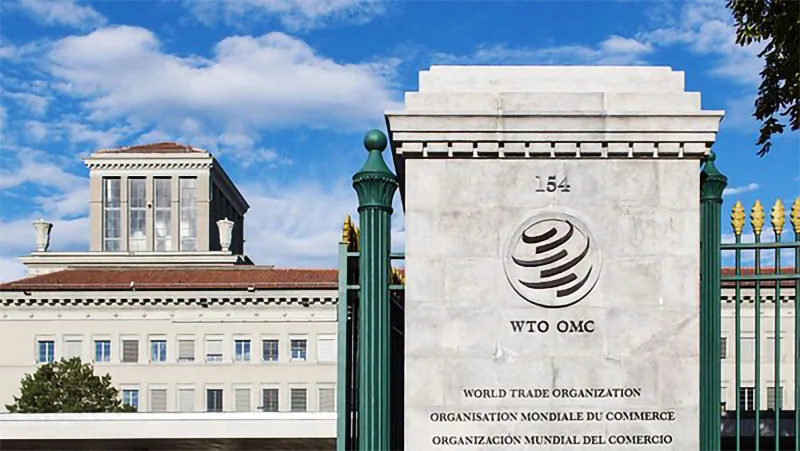
(Continued from yesterday)
Critique of the International Trade System
President Trump’s tariffs have also highlighted fundamental inequities in the international trade and financial architecture that governs economic relations between wealthy and developing nations.
The World Trade Organization, theoretically designed to provide a rules-based trading system that benefits all members, has proven largely powerless to prevent unilateral actions by powerful economies like the United States. While China has urged the WTO to investigate President Trump’s tariffs as violations of the “most favoured nation” principle that forms the bedrock of the multilateral trading system, the organization lacks effective enforcement mechanisms against major powers.
Similarly, international financial institutions like the IMF have failed to adequately account for trade shocks in their lending programmes and debt sustainability analyses. As discussed earlier, the IMF’s approach to Sri Lanka’s debt restructuring focused primarily on fiscal consolidation while paying insufficient attention to the country’s
Page 17 of 29
structural trade deficit and vulnerability to external shocks. When Trump’s tariffs suddenly reduce Sri Lanka’s export earnings, the IMF program offers no automatic adjustment mechanisms to accommodate this changed reality.
This situation stands in stark contrast to historical examples of more equitable treatment of indebted nations. The London Debt Agreement of 1953, which restructured West Germany’s external debts, explicitly linked repayment obligations to the country’s trade performance and capped debt service at a sustainable percentage of export earnings. Such an approach recognised the fundamental importance of trade capacity to debt sustainability, a recognition largely absent from contemporary debt restructuring frameworks.
The tariff shock thus reveals not merely technical flaws in trade policy but deeper structural inequities in how the global economic system distributes risks, rewards, and adjustment costs between wealthy and developing nations. While powerful economies can unilaterally reshape trading relationships to serve their domestic political objectives, developing countries must largely accept these changes as given constraints and bear disproportionate costs of adjustment.
Potential Reshaping of Global Trade Patterns
Looking beyond the immediate disruption, President Trump’s tariffs may accelerate several longer-term shifts in global trade patterns with significant implications for developing economies.
First, we may see accelerated regionalisation of trade as countries seek to reduce vulnerability to U.S. policy shifts. Asian economies may deepen integration through mechanisms like the Regional Comprehensive Economic Partnership (RCEP), while African countries might accelerate the implementation of the African Continental Free Trade Area (AfCFTA). These regional arrangements could provide alternative markets for exports previously destined for the United States, though the transition would be neither quick nor painless.
Second, China’s role as both a market and investor for developing economies may expand further. As U.S. tariffs effectively close off portions of its market, developing countries may look more intensively toward China as an export destination and source of development finance. This shift would have significant geopolitical implications, potentially accelerating the fragmentation of the global economy into competing blocs centred around major powers.
Page 18 of 29
Third, some production may relocate to avoid tariffs, creating winners and losers among developing countries. Nations with lower tariff rates or special exemptions could see increased investment as firms restructure supply chains to minimise trade costs. This dynamic could intensify competition among developing countries for foreign investment, potentially triggering a “race to the bottom” on labour and environmental standards.
Fourth, there may be renewed interest in domestic market development and South-South trade as alternatives to excessive dependence on wealthy consumer markets. While the limited purchasing power in many developing countries constrains this option in the short term, over time it could lead to more balanced and resilient development models.
These potential shifts suggest that President Trump’s tariffs may represent not merely a temporary disruption but a catalyst for more fundamental reconfiguration of global trade patterns. For developing economies like Sri Lanka, navigating this changing landscape will require strategic foresight, policy innovation, and international cooperation to ensure that the emerging trade architecture better serves their development needs than the system currently being disrupted.
POTENTIAL MITIGATION STRATEGIES FOR SRI LANKA
Faced with the severe economic challenge posed by Trump’s 44% tariff, Sri Lanka must develop a comprehensive response strategy that addresses both immediate threats and longer-term structural vulnerabilities. This section explores potential approaches at different time horizons, from emergency measures to fundamental economic reorientation.
Short-term Responses
In the immediate term, Sri Lanka’s government and private sector must focus on crisis management to minimise damage to export industries and protect vulnerable workers. Several approaches warrant consideration.
Government Support for Affected Industries
The Sri Lankan government could implement targeted support measures for export sectors most affected by the tariffs, particularly the textile and apparel industry. These might include temporary tax relief, subsidised credit facilities, or reduced
Page 19 of 29
utility rates for export-oriented manufacturers. Such measures could help companies weather the initial shock while they develop adaptation strategies.
However, Sri Lanka’s fiscal constraints present a significant challenge to implementing such support. The country’s IMF programme imposes strict limits on government spending and deficit targets, while tax increases have been a central component of the economic stabilisation strategy. Any support measures would therefore need to be carefully designed to remain within these constraints or negotiated as exceptions with the IMF based on the external nature of the shock.
One potential approach would be to reallocate existing resources rather than expanding overall spending. For instance, funds previously earmarked for export promotion in the U.S. market, if any, could be redirected toward supporting market diversification efforts or providing temporary relief to affected companies.
Diplomatic Engagement with the United States
Sri Lanka should pursue active diplomatic engagement with the United States to seek modifications to the tariff regime. While the country’s limited economic leverage makes a complete exemption unlikely, there may be opportunities to negotiate targeted relief for specific product categories or to secure technical assistance for adjustment.
The Sri Lankan government could emphasise several arguments in these discussions, the disproportionate impact of the tariffs on a country still recovering from economic crisis, the potential humanitarian consequences of mass unemployment in the textile sector, and the strategic importance of economic stability in Sri Lanka for regional security in the Indian Ocean.
One of the most compelling arguments Sri Lanka can make is the need to move beyond narrow fixation on the trade balance and instead consider a broader current account. While Sri Lanka may show a surplus in goods trade with the U.S., that figure is only a part of the story. Our economy is deeply integrated with U.S. linked services. We pay for American banking and credit card services, subscribe to streaming platforms like Netflix and Amazon, purchase of software and apps from Apple and Google, remit interest payment on loans from international banks, bond holders and multilateral institutions, and spend on tourism and education. When all of these outflows are taken into account, the so called “imbalance” is far more nuanced if not fully offset. This is why a fair and modern economic analysist must consider the full current account, not just goods trade in isolation.
Page 20 of 29
Engagement should occur through multiple channels, including direct bilateral discussions, multilateral forums like the WTO, and coordination with other affected developing countries to amplify collective concerns. Sri Lanka might also leverage its relationships with international financial institutions like the World Bank and IMF, which could highlight the risks the tariffs pose to the country’s economic recovery program.
Emergency Economic Measures
If the full impact of the tariffs materializes, Sri Lanka may need to implement emergency economic measures to maintain macroeconomic stability. These could include temporary foreign exchange controls to prioritize essential imports, accelerated disbursement of already-committed international financial support, or emergency borrowing from friendly countries or international institutions.
The Central Bank of Sri Lanka might need to adjust monetary policy to respond to potential currency pressures resulting from reduced export earnings. However, any such adjustments would need to be balanced against inflation concerns, which remain sensitive following the recent crisis.
Social Protection for Affected Workers
Protecting workers who lose jobs or face reduced hours due to the tariff impact should be a priority. The government could expand existing social safety net programs to specifically target affected textile workers, potentially with support from international donors or development agencies.
Measures might include temporary unemployment benefits, retraining programmess for displaced workers, or community-based support initiatives in areas with high concentrations of textile employment. Given fiscal constraints, international support would likely be necessary to fund such programmes adequately.
Medium to Long-term Strategies
Beyond immediate crisis response, Sri Lanka must develop strategies to reduce vulnerability to future trade shocks and create a more resilient economic model. Several approaches deserve consideration.
Page 21 of 29
Market Diversification Beyond the United States
Reducing dependence on the U.S. market represents an obvious but challenging strategy. Potential alternative markets include,
* European Union: Already Sri Lanka’s second-largest export destination, the EU offers preferential access through its GSP+ scheme. Expanding exports to Europe would require meeting stringent standards and potentially adjusting product offerings to suit European consumer preferences.
* Regional Markets: Increasing exports to India, China, and other Asian economies could leverage geographical proximity and growing middle-class consumer bases. This would require navigating complex regional trade agreements and potentially developing new product categories better suited to these markets.
* Emerging Markets: Countries in the Middle East, Africa, and Latin America represent potential growth opportunities, though penetrating these markets would require significant market research and relationship building.
The Joint Apparel Association Forum’s statement that “We have no alternate market that we can possibly target instead of the US” reflects the difficulty of this transition. Established buyer relationships, specialized production capabilities, and compliance certifications all create path dependencies that make market diversification a multi-year project rather than an immediate solution.
Product Diversification Beyond Textiles
Sri Lanka’s heavy reliance on textile and apparel exports creates vulnerability to sector-specific shocks. Diversifying the export basket could create greater resilience, though this too represents a long-term structural challenge rather than a quick fix.
Promising sectors for export diversification include:
* Information Technology and Business Process Outsourcing: Sri Lanka has developed a growing IT/BPO sector that could be expanded with appropriate investment in education, infrastructure, and international marketing.
* High-Value Agricultural Products: Speciality tea, spices, and organic produce could command premium prices in international markets while building on Sri Lanka’s agricultural traditions.
Page 22 of 29
Sustainable Manufacturing: Leveraging Sri Lanka’s relatively strong environmental credentials to develop green manufacturing capabilities in emerging sectors like electric vehicle components or renewable energy equipment.
Tourism Services: While not directly affected by goods tariffs, expanding tourism could help diversify foreign exchange earnings. However, this sector’s vulnerability to external shocks (as demonstrated during the pandemic) suggests it should be one component of a diversification strategy rather than its centrepiece.
Successful product diversification would require coordinated public-private investment in research and development, skills training, quality infrastructure, and international marketing. It would also necessitate a supportive policy environment that reduces barriers to innovation and entrepreneurship.
Value Chain Upgrading
Even within existing export sectors like textiles, Sri Lanka could pursue strategies to capture more value and reduce vulnerability to tariffs. Moving up the value chain from basic contract manufacturing to design, product development, branding, and direct-to-consumer sales could increase margins and provide greater control over market access.
Some Sri Lankan companies have already begun this transition, developing their own brands or establishing direct relationships with consumers through e-commerce platforms. Government support for such initiatives through design education, intellectual property protection, and export promotion could accelerate this evolution.
Regional Trade Integration
Deepening integration with regional trade blocs could provide both alternative markets and opportunities for participation in regional value chains. Sri Lanka is a member of the South Asian Free Trade Area (SAFTA) and has bilateral trade agreements with India, Pakistan, and Singapore, and more recently with Thailand, though implementation challenges have limited their effectiveness.
More ambitious regional integration through mechanisms like the Regional Comprehensive Economic Partnership (RCEP) or the proposed Bay of Bengal Initiative for Multi-Sectoral Technical and Economic Cooperation (BIMSTEC) Free
Page 23 of 29
Trade Area could create new opportunities. However, managing domestic concerns about increased competition from larger economies like India and China would require careful policy design and implementation. (To be continued)
(The writer served as the Minister of Justice, Finance and Foreign Affairs of Sri Lanka)
Disclaimer:
This article contains projections and scenario-based analysis based on current economic trends, policy statements, and historical behaviour patterns. While every effort has been made to ensure factual accuracy using publicly available data and established economic models, certain details, particularly regarding future policy decisions and their impacts, remain hypothetical. These projections are intended to inform discussion and analysis, not to predict outcomes with certainty.
(To be concluded)
-

 News5 days ago
News5 days agoJapan-funded anti-corruption project launched again
-

 Sports4 days ago
Sports4 days agoOTRFU Beach Tag Rugby Carnival on 24th May at Port City Colombo
-

 News5 days ago
News5 days agoSethmi Premadasa youngest Sri Lankan to perform at world-renowned Musikverein in Vienna
-

 Business5 days ago
Business5 days agoNational Savings Bank appoints Ajith Akmeemana,Chief Financial Officer
-

 News2 days ago
News2 days agoRanil’s Chief Security Officer transferred to KKS
-

 Features3 days ago
Features3 days agoThe Broken Promise of the Lankan Cinema: Asoka & Swarna’s Thrilling-Melodrama – Part IV
-

 Features4 days ago
Features4 days agoTrump tariffs and their effect on world trade and economy with particular
-

 News3 days ago
News3 days agoRadisson Blu Hotel, Galadari Colombo appoints Marko Janssen as General Manager





